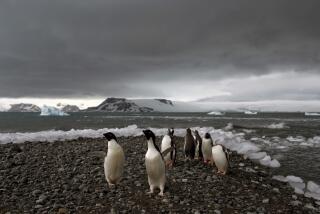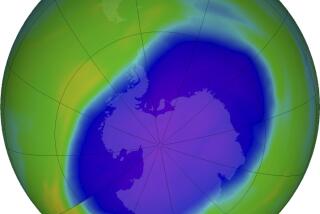Antarctica’s Ozone Shield Shrinks to Thinnest Ever
WASHINGTON — The ozone shield over Antarctica, which provides vital protection from harmful ultraviolet rays, grew thinner in September than at any time previously recorded, government scientists announced Wednesday.
The ozone level dropped to 15% lower than recorded in the previous low year of 1985, according to preliminary findings of new experiments disclosed by scientists of the National Aeronautics and Space Administration and the National Oceanic and Atmospheric Administration.
The experiments, the most extensive yet conducted over Antarctica, offer tentative answers to many of the baffling questions about why the amount of ozone over Antarctica decreases drastically each spring, causing an ozone “hole” that has grown deeper since it was first measured in the late 1970s, the scientists said.
They cautioned that it is too early to offer final conclusions from the experiments, which were not completed until Wednesday. But they added that it is important to share a “provisional picture” of the Antarctic ozone hole to “stimulate the scientific inquiry and debate” about an issue of “justifiable public concern.”
The experiments, conducted aboard space agency planes at high altitudes, provided evidence suggesting that the rapid destruction of ozone over Antarctica is caused by a combination of chemical chlorofluorocarbons present in the atmosphere around the world and by meteorological factors peculiar to Antarctica, the scientists said.
Scientists have long recognized that chlorofluorocarbons--which are present in air conditioners, Styrofoam containers and other products--might destroy ozone, the only gas in the Earth’s atmosphere that blocks ultraviolet radiation from the sun, which is blamed for thousands of skin cancer cases each year.
Recognition of the danger of chlorofluorocarbons led to the banning of their use as spray-can propellants in the United States and other countries in the 1970s.
More recently, representatives of the United States and 45 other nations earlier this month agreed to the Montreal Protocol, a U.N.-sponsored international agreement freezing consumption and production of chlorofluorocarbons at 1986 levels beginning in 1990 and reducing that level by 50% by 1999.
What has baffled scientists since 1985, when a British team first noted the Antarctic ozone hole, has been the fact that Antarctic ozone levels have been depleted so rapidly while changes elsewhere have been difficult to discern.
The new NASA experiments suggest that the explanation lies in an “exquisite interplay between meteorology and chemistry,” said Dan Albritton of NOAA. The severe cold and particular wind patterns in the atmosphere above Antarctica help to transform the chlorofluorocarbons into active chlorine compounds that destroy ozone, said Albritton and his colleague from NASA, Dr. Robert Watson.
The experiments found that levels of chlorine increased as levels of ozone decreased over Antarctica, suggesting that the chemical was responsible for the ozone depletion, said the two scientists, who coordinated the 100-person team which conducted the study from a base in Punta Arenas, Chile.
But the fact that levels of ozone dropped at uneven rates--by as much as 50% in a single day in one location--suggests that chemical explanations for ozone depletion were not sufficient by themselves. “It is important to recognize that meteorology is critical,” Watson said.
The scientists said also that their new evidence disproved theories of ozone depletion that focused on meteorological phenomena such as the large-scale upwelling of air masses in the region. Also mistaken, they said, was another major theory contending that solar activity was responsible for the Antarctic ozone hole.
More to Read
Sign up for Essential California
The most important California stories and recommendations in your inbox every morning.
You may occasionally receive promotional content from the Los Angeles Times.









